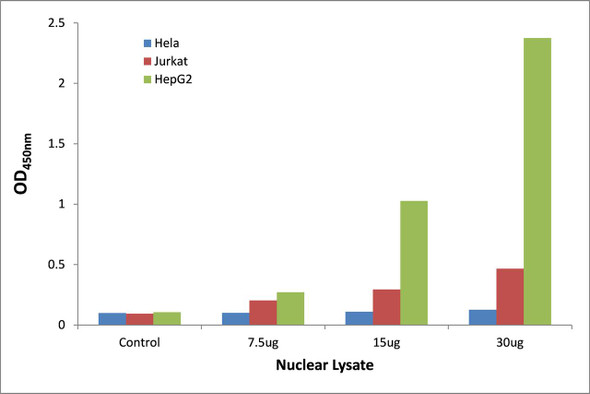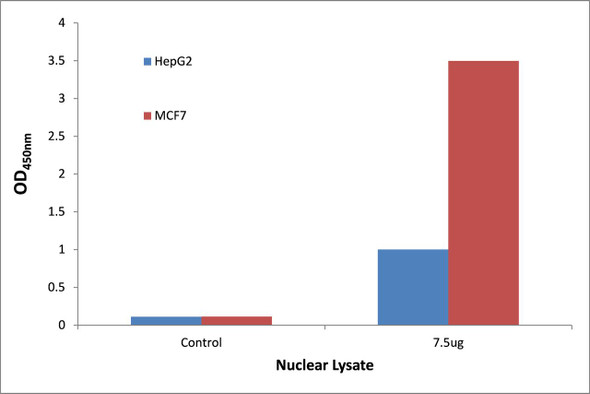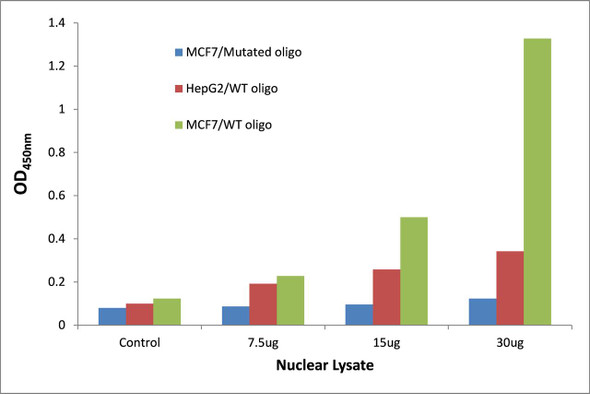Description
system_update_altDatasheet
| Product Name: | NFYA Transcription Factor Activity Assay |
| Product Code: | TFAB00142 |
| Target: | NFYA |
| Synonyms: | CAAT box transcription factor activity protein subunit A, Nuclear transcription factor Y subunit A, NF-YA |
| Reactivity: | Human, Mouse, Rat |
| Sample Types: | Nuclear or cell lysates |
The Assay Genie NFYA transcription factor activity assay allows for the detection and qualitative analysis of endogenous levels of activated transcription factors in a variety of nuclear and cell lysates
Assay Genie ELISA kits are designed to significantly reduce experiment time and ensure sensitivity and flexibility for high-throughput screening.
| Assay Time: | 4.5 hours |
| Detection Method: | Colorimetric 450 nm |
| Size: | 12 x 8-Well Microstrips |
| Storage: | 4°C for 6 months |
| UniProt Protein Function: | NFYA: stimulates the transcription of various genes by recognizing and binding to a CCAAT motif in promoters, for example in type 1 collagen, albumin and beta-actin genes. Heterotrimeric transcription factor composed of three components, NF-YA, NF-YB and NF-YC. Involved in cisplatin resistance. NF-YB and NF-YC must interact and dimerize for NF-YA association and DNA binding. 2 isoforms of the human protein are produced by alternative splicing. |
| UniProt Protein Details: | Protein type:DNA-binding; Transcription factor Chromosomal Location of Human Ortholog: 6p21.1 Cellular Component: CCAAT-binding factor complex; nucleoplasm; nucleus Molecular Function:DNA binding; protein binding Biological Process: positive regulation of transcription, DNA-dependent; regulation of transcription, DNA-dependent; transcription from RNA polymerase II promoter |
| NCBI Summary: | The protein encoded by this gene is one subunit of a trimeric complex, forming a highly conserved transcription factor that binds to CCAAT motifs in the promoter regions in a variety of genes. Subunit A associates with a tight dimer composed of the B and C subunits, resulting in a trimer that binds to DNA with high specificity and affinity. The sequence specific interactions of the complex are made by the A subunit, suggesting a role as the regulatory subunit. In addition, there is evidence of post-transcriptional regulation in this gene product, either by protein degradation or control of translation. Further regulation is represented by alternative splicing in the glutamine-rich activation domain, with clear tissue-specific preferences for the two isoforms. [provided by RefSeq, Jul 2008] |
| UniProt Code: | P23511 |
| NCBI GenInfo Identifier: | 115844 |
| NCBI Gene ID: | 4800 |
| NCBI Accession: | P23511.2 |
| UniProt Secondary Accession: | P23511,Q8IXU0, |
| UniProt Related Accession: | P23511 |
| Molecular Weight: | 37kDa |
| NCBI Full Name: | Nuclear transcription factor Y subunit alpha |
| NCBI Synonym Full Names: | nuclear transcription factor Y subunit alpha |
| NCBI Official Symbol: | NFYA |
| NCBI Official Synonym Symbols: | HAP2; CBF-A; CBF-B; NF-YA |
| NCBI Protein Information: | nuclear transcription factor Y subunit alpha |
| UniProt Protein Name: | Nuclear transcription factor Y subunit alpha |
| UniProt Synonym Protein Names: | CAAT box DNA-binding protein subunit A; Nuclear transcription factor Y subunit A; NF-YA |
| Protein Family: | Nuclear transcription factor |
| UniProt Gene Name: | NFYA |






